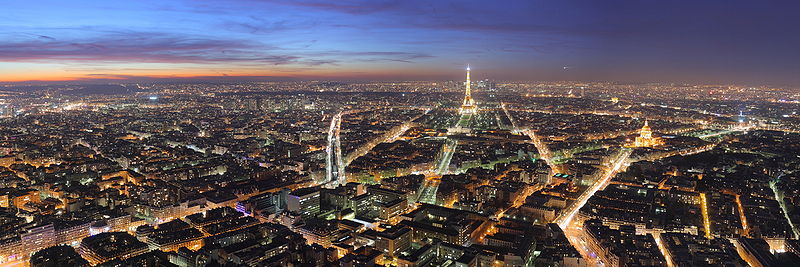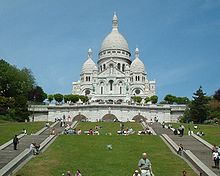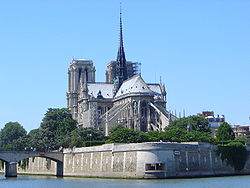Paris – Impressions

Three of the most famous Parisian landmarks are the twelfth-century cathedral Notre Dame de Paris on the Île de la Cité, the Napoleonic Arc de Triomphe and the nineteenth-century Eiffel Tower. The Eiffel Tower was a "temporary" construction by Gustave Eiffel for the 1889 Universal Exposition, but the tower was never dismantled and is now an enduring symbol of Paris. The Historical axis is a line of monuments, buildings, and thoroughfares that run in a roughly straight line from the city-centre westwards: The line of monuments begins with the Louvre and continues through the Tuileries Gardens, the Champs-Élysées, and the Arc de Triomphe, centred in the Place de l'Étoile circus. From the 1960s, the line was prolonged even further west to the La Défense business district dominated by square-shaped triumphal Grande Arche of its own; this district hosts most of the tallest skyscrapers in the Paris urban area.
Montmartre
 Is a historic area on the Butte, home to the Basilique du Sacré-Cœur. Montmartre has always had a history with artists and has many studios and cafés of many great artists in that area.
Montmartre is a hill (the butte Montmartre) which is 130 meters high, giving its name to the surrounding district, in the north of Paris in the 18th arrondissement, a part of the Right Bank. Montmartre is primarily known for the white-domed Basilica of the Sacré Cœur on its summit and as a nightclub district. The other, older, church on the hill is Saint Pierre de Montmartre, which claims to be the location at which the Jesuit order of priests was founded. Many artists had studios or worked around the community of Montmartre such as Salvador Dalí, Amedeo Modigliani, Claude Monet, Pablo Picasso and Vincent van Gogh. Montmartre is also the setting for several hit films. This site is served by metro line 2 stations of Anvers, Pigalle and Blanche and the line 12 stations of Pigalle, Abbesses, Lamarck - Caulaincourt and Jules Joffrin.
Is a historic area on the Butte, home to the Basilique du Sacré-Cœur. Montmartre has always had a history with artists and has many studios and cafés of many great artists in that area.
Montmartre is a hill (the butte Montmartre) which is 130 meters high, giving its name to the surrounding district, in the north of Paris in the 18th arrondissement, a part of the Right Bank. Montmartre is primarily known for the white-domed Basilica of the Sacré Cœur on its summit and as a nightclub district. The other, older, church on the hill is Saint Pierre de Montmartre, which claims to be the location at which the Jesuit order of priests was founded. Many artists had studios or worked around the community of Montmartre such as Salvador Dalí, Amedeo Modigliani, Claude Monet, Pablo Picasso and Vincent van Gogh. Montmartre is also the setting for several hit films. This site is served by metro line 2 stations of Anvers, Pigalle and Blanche and the line 12 stations of Pigalle, Abbesses, Lamarck - Caulaincourt and Jules Joffrin.
Notre Dame de Paris
 Notre Dame de Paris (French for Our Lady of Paris), also known as Notre Dame Cathedral, is a Gothic, Catholic cathedral on the eastern half of the Île de la Cité in the fourth arrondissement of Paris, France. It is the cathedral of the Catholic Archdiocese of Paris: that is, it is the church that contains the cathedra (official chair), of the Archbishop of Paris, currently André Vingt-Trois. Notre Dame de Paris is widely considered one of the finest examples of French Gothic architecture in France and in Europe. It was restored and saved from destruction by Eugène Viollet-le-Duc, one of France's most famous architects. The name Notre Dame means "Our Lady" in French, and is frequently used in the names of Catholic church buildings in Francophone countries. Notre Dame de Paris was one of the first Gothic cathedrals, and its construction spanned the Gothic period. Its sculptures and stained glass show the heavy influence of naturalism, unlike that of earlier Romanesque architecture.
Notre Dame de Paris (French for Our Lady of Paris), also known as Notre Dame Cathedral, is a Gothic, Catholic cathedral on the eastern half of the Île de la Cité in the fourth arrondissement of Paris, France. It is the cathedral of the Catholic Archdiocese of Paris: that is, it is the church that contains the cathedra (official chair), of the Archbishop of Paris, currently André Vingt-Trois. Notre Dame de Paris is widely considered one of the finest examples of French Gothic architecture in France and in Europe. It was restored and saved from destruction by Eugène Viollet-le-Duc, one of France's most famous architects. The name Notre Dame means "Our Lady" in French, and is frequently used in the names of Catholic church buildings in Francophone countries. Notre Dame de Paris was one of the first Gothic cathedrals, and its construction spanned the Gothic period. Its sculptures and stained glass show the heavy influence of naturalism, unlike that of earlier Romanesque architecture.
Cuisine

Paris' culinary reputation has its base in the diverse origins of its inhabitants. In its beginnings, it owed much to the 19th-century organisation of a railway system that had Paris as a centre, making the capital a focal point for immigration from France's many different regions and gastronomical cultures. This reputation continues through today in a cultural diversity that has since spread to a worldwide level thanks to Paris' continued reputation for culinary finesse and further immigration from increasingly distant climes.
Some addresses
Astier - Benoît
L'Ambroisie - La Rôtisserie d'En Face - La tour d'Argent
many other
Parks and gardens
Two of Paris' oldest and famous gardens are the Tuileries Garden, created in the 16th century for a palace on the banks of the Seine near the Louvre, and the Left bank Luxembourg Garden, another former private garden belonging to a château built for the Marie de' Medici in 1612. The Jardin des Plantes, created by Louis XIII's doctor Guy de La Brosse for the cultivation of medicinal plants, was Paris' first public garden. A few of Paris' other large gardens are Second Empire creations: The former suburban parks of Montsouris, Parc des Buttes Chaumont, and Parc Monceau (formerly known as the "folie de Chartres") are creations of Napoleon III's engineer Jean-Charles Alphand. Another project executed under the orders of Baron Haussmann was the re-sculpting of Paris' western Bois de Boulogne forest-parklands; the Bois de Vincennes, on the city's opposite eastern end, received a similar treatment in years following. Newer additions to Paris' park landscape are the Parc de la Villette, built by the architect Bernard Tschumi on the location of Paris' former slaughterhouses, the Parc André Citroën, and gardens being laid to the periphery along the traces of its former circular "Petite Ceinture" railway line: Promenade Plantée.